![]() Much thanks to LSSU in Sault Ste Marie, Michigan for hosting our weekend of yoga explorations, November 11 – 13. The classes were blessed with an amazing spectrum of students. There were parents bringing their children, ranging from 5 months, to 5, 6 and 8 years old; college students, University teachers, yoga teachers, and many of us on the other side of 60 and 70. The college students were a great inspiration, bringing energy, enthusiasm and creativity to the group. What follows is a brief summary of the points covered, some class details, and some links for further studies.
Much thanks to LSSU in Sault Ste Marie, Michigan for hosting our weekend of yoga explorations, November 11 – 13. The classes were blessed with an amazing spectrum of students. There were parents bringing their children, ranging from 5 months, to 5, 6 and 8 years old; college students, University teachers, yoga teachers, and many of us on the other side of 60 and 70. The college students were a great inspiration, bringing energy, enthusiasm and creativity to the group. What follows is a brief summary of the points covered, some class details, and some links for further studies.
Unique and Universal
Unique: Make your practice your own. Authenticity is crucial in self exploration and self discovery. Every pose and every specific practice can be matched to your needs in the present moment. Learn to be sensitive to what your body/mind soul is requesting right now. In a yoga class, trust your inner instincts about what you are doing. This may not be easy as a beginner, but if you ‘trust’ that the body knows’, even a new student can tell when something does not feel right. Most yoga classes are based on conformity at some level, with students going through the same poses at the same time. (Chaos is not an easy thing to guide!) But even so, you can find a pace that works for you.
Universal, pt 1: There is a spiritual practice, a ‘yoga’ practice available for anyone, from a 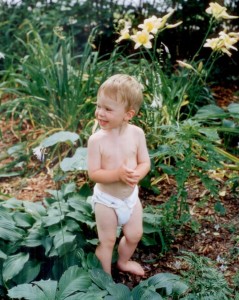 young child (SBK, born 12/14/96) to someone on their death bed (BKS, born 12/14/18); from a highly trained athlete to an ex-couch potato: from a ‘type A” world conqueror to a laid back hippy. (Your unique needs may
young child (SBK, born 12/14/96) to someone on their death bed (BKS, born 12/14/18); from a highly trained athlete to an ex-couch potato: from a ‘type A” world conqueror to a laid back hippy. (Your unique needs may 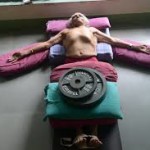 require a balancing practice complementary to your dominant mode of being !)
require a balancing practice complementary to your dominant mode of being !)
Universal. pt 2: There are also universal principles that apply to all practices. Know these few intimately. “Always stay centered in your heart.” “Keep the breath/prana/chi moving at all times.” “Work with pairs of energy, the yin and yang, in every action, and find the place/feeling of dynamic balance.” “Warm up and cool down if you are practicing dynamically.” ” Constantly check in with ‘how it feels’, using this as the root of your next action. “Bring your practice into the world. Do not leave it on your mat.”
Awareness and Attention:
Awareness is a synonym for the Infinite Silence or Unbounded Stillness, that is the ‘Universal’ source of all. What arises, creation, what we can become aware of, we observe and study through the art of ‘paying attention’. We all create a unique perspective on life through the direction of our attentional field. To grow, we must continually expand the range and variety of our perceptions. In a somatic practice like hatha yoga, we expand our sensitivity into the inner worlds of: proprioception (feeling the breath and other energy) flows coming from within: kinesthesia (the feeling of how the various parts of the body move together. In meditation praction, we expand into self observation of the thoughts and emotions that flow through us moment to moment. In our relational yoga, we notice how our personal energy fields overlap and interact with others. In all of these explorations, we are looking to find more healing, lightness of being, kindness, ease and love.
Matter and Energy: Our attention/identification tends be on abstract thought. When our attention is brought to the body, we often ‘grab onto’ some structure like a muscle or bone to ‘land’. This is a clunky way to be in relationship with the body. If we can shift to an energy based sense of self, we begin to find and feel the chi, the flow that is our aliveness, and our body becomes our teacher, a living presence looking to express the divine light that is our universal fundamental nature. This requires bringing attention to the breath and its more subtle dimensions.
Seven Sacred Directions: please click for a detailed look at these.
Friday Evening Class:
Use a bolster, block or folded blanket for support in sitting. Your lower back will collapse without this and you will either sink down, or overwork trying to sit upright.
Three Limbs of Meditation:
1. Concentration or focal attention: Sustaining your attention in one place over time. Bring your attention to your breathing. If and when it wanders, bring your attention back to the breath.
2. Open Attention or mindfulness: Stay in the present moment, open to whatever arises. If and when you become distracted by following and getting lost in a thought or sensation, come back to open attention.
3. Contemplation: Hold a spiritual question or pithy phrase, (a Zen koan) in the mind field without trying to come up with an immediate answer. Let the question or phrase sit quietly, with the deeper dimensions of mind slowly adding their perspective.
Basic Standing Poses
please click to see the origins of these poses as three basic movements of the pelvis
Relaxation
Saturday Morning Class: Sound and breath: Open up your ‘ahs’ and ‘oohs’ to help clear the energy channels. Sustain the sound by balancing the action of the ribs and diaphragm.
Finding your core channel: Click here for more on the 7 sacred directions and relationship of the navel to the core.
Then, click on following link : Dog Pose and Variations
Pinning the clavicles: To help stabilize the shoulders when the arms are weight bearing, we begin by anchoring the collar bone to the sternum at the sterno-clavicular joint. You can use the fingers of the opposite hand to feel this. Now imagine the other end of the clavicle pinning itself to the shoulder blade at the achromion process. The clavicle feels as it is now extending in two opposite directions. The two ends have to be awake to allow the shoulder a healthy balance of both stability and mobility. Try the dog pose and variations again and compare the feelings. Flipping the dog requires an awakened clavicle to protect the shoulder during the weight bearing rotation it must do.
Now try vasisthasana, the side plank.  We just played with the beginning level. If you feel inspired try variations 2 and 3.
We just played with the beginning level. If you feel inspired try variations 2 and 3. 

Anantasana and variations: 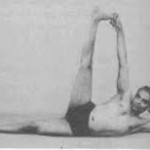 more practice on the balance from lateral line. Iyengar is doing the final pose. We began with the legs parallel and stabilized any wobbling through the core.
more practice on the balance from lateral line. Iyengar is doing the final pose. We began with the legs parallel and stabilized any wobbling through the core.
Saturday Afternoon class: The three pressure cavities, the five Prana Vayus, and Pranayama.
The heart center organizes the field that sustains the breath through the three pressure cavities of the body: the skull, the chest from the roof of the mouth to the diaphragm, and the belly, from the diaphragm to the pelvic floor. The skull and belly have a positive, or higher pressure, relative to the outside, and the chest is lower or negative. This creates a constant flow from skull and belly to the chest, as higher pressure will move toward the lower, and helps support the flow of blood back to the heart.
The problem is that, over time, many humans let the higher belly pressure push out, rather then up and down. Same in the head. And the negative chest pressure leads to a collapse of the ribs in and down. This leads to a very common postural shape. We can begin to 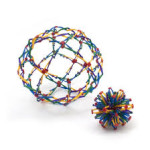 restore the happiness of balance by learning to sustain an expanding rib cage, independent of inhalation and exhalation. Imagine the primary action of the heart center is expansion, like the opening of a hoberman sphere. In standing feel how this can help the brain empty downward and the lower body energy rise up. This unified field will then support all other physiological movements in the body.
restore the happiness of balance by learning to sustain an expanding rib cage, independent of inhalation and exhalation. Imagine the primary action of the heart center is expansion, like the opening of a hoberman sphere. In standing feel how this can help the brain empty downward and the lower body energy rise up. This unified field will then support all other physiological movements in the body.
In yogic terms, physiological movements are divided into five basic categories, known as the Prana Vayus, where vayu refers to the element air or movement. The first is called prana, (with a small p, to differentiate it from the “Prana” which refers to all of the five), is centered in the chest, and governs everything we take in. For our purposes, this is inhalation. From our unified field exploration, the chest should always feel expanding. The second is the apana, governs elimination, and is centered in the lower belly. It is a squeezing energy, and thus the belly should always feel that it is slightly squeezing inward. When prana and apana work as a single intelligence, you have the energetic support for what is now commonly called ‘core strength’.
The samana vayu governs digestion, deciding what to keep, what to eliminate, and generating energy from the oxygen of the breath and the food. Vyana is circulation, distributing the energy throughout the body, and udana is in charge of growth and development.
Breath explorations: pt.1: lying on the floor, supported as necessary to relax the spinal muscles and limbs, begin to relax the breathing more and more. Track the release down through your feet and out through your arms, as well as through head and tail. Pay special attention to the region form the diaphragm downward and try to empty it of as muchtension as possible, so the breath becomes effortless.
Pt.2: Now, without losing that softness, become aware of the ribs and invite them to expand sideways as the primary action of inhalation. Not up and down, not out into the belly, but sideways, like an accordion. On the exhalation, let the belly/abdominal wall squeeze the breaht out by pushing up on the diaphragm. This will ‘stretch’ the diaphragm, which may be tight. The ribs can slowly return, but feel the expanding energy still strong. Keeping the chest open (prana) lets the diaphragm stretch even more as the squeezing apana pushes the diaphragm higher into the more spacious chest.
Pt 3: Viloma Pranayama: here we choose to divide the inhalation and exhalation into stages, rather than a continuous flow. Viloma I divides the inbreath with a normal exhalation; viloma II divides the exhalation with a normal inbreath. The dividing creates a series of pauses, like walking up or down stairs. There may be 2 or 3 pauses, or even more if you are comfortable. What happens during those pauses is what makes Viloma such a rich practice. Our intention here is to balance the expanding prana and the squeezing apana, helping them work together.
Viloma I: on each of the pauses during the inhalation, squeeze the abdomen slightly and open the chest more. As a beginner, you may actually exhale slightly during the pauses. This is just fine. Two steps forward and one back will eventually create a nice soft long inhalation.
Viloma II: on each of the pauses during the exhalation, expand the chest a bit more and squeeze the belly. As a beginner, you may actually inhale slightly during the pauses. This is just fine. Two steps forward and one back will eventually create a nice soft long exhalation.
Pt. 4 feel the effects of the practice and then lie in savasana and enjoy the deep stillness.
Sunday Morning Class: Some fun energy patterns we can play with to help discover more freedom in movement.
Three basic walking gaits: Explore contralateral, (opposite arm and leg move together); homo-lateral (same arm and leg move together); and homologous ( alternating upper and lower limbs like a frog jumping) walking patterns. Walk around and compare the feelings, sensations, and emotions evoked by each pattern.
Walk by isolating each of the three pelvic axes: Flexion/extension, lateral flexion/extension and rotation. How do they feel? Which is most familiar.
Flexion and Extension in the feet knees and hips: to help with knee injuries, learn to act from an integrating flow patterns that includes all joints. From standing, the up lifting or spring loading spiral includes supination (inversion) of the foot, flexion of the knee and hip, and external rotation of the hip. This brings you into a vrksasana like position, or, with a few additional trunk movements, the loaded spring position to begin a martial arts side kick. The down or grounding spiral is the reverse. Internal hip rotation, extension of hip and knee, and pronation (eversion) of the foot. This is the firing of the leg in a side kick.
The pathology is to over work the knees, either by initiating the action from them or jumping in with the quads and bypassing the inner flow. Begin in supta padangusthasana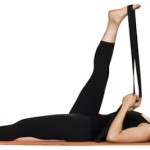 , but use the belt or strap to offer resistance as you bend the knee into the up spiral, and extend out. Do not let the knee overwork. Let it receive the flow and move from flexion through extension and back from within.
, but use the belt or strap to offer resistance as you bend the knee into the up spiral, and extend out. Do not let the knee overwork. Let it receive the flow and move from flexion through extension and back from within.
Take this into your standing poses, especially triangle and parsvakonasana.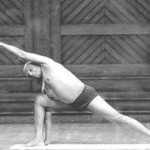
Then explore, beginning in one leg tadasana (see photo right) and then bending and rotating 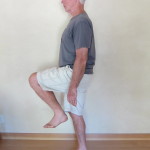 the hips while extending the leg to half moon pose. A wall is helpful.
the hips while extending the leg to half moon pose. A wall is helpful. 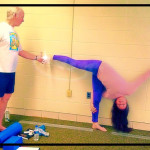
From half moon, rotate into revolved half moon. 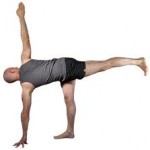 Then go back and forth to open the hips. Then carry this awareness into the dog pose series from above. Then, from there, add hand stand
Then go back and forth to open the hips. Then carry this awareness into the dog pose series from above. Then, from there, add hand stand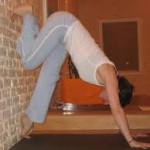 , climbing up the wall to find the action in the hips
, climbing up the wall to find the action in the hips
Preparing the sacrum for backbending poses. Using a block for support, find a fulcrum where the tail and lumbar release in opposite directions away 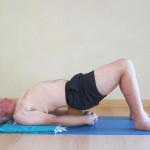
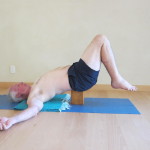
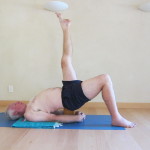
for the sacrum to open and lengthen the center of the pelvis. Then add the free flowing anemone to the sequence.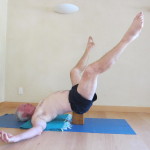 Keep the chest open without contracting the spine.
Keep the chest open without contracting the spine.
From Lying to Standing: the spiral unfolds: 1. Lying on your back, feel how you cannot move well, but your hands are free to explore. Then, from lying on your back, find a way to roll over onto your belly without using arms or legs, hands or feet. Use momentum of your fluid body. Feel the urge to move. Try the homolateral or contralateral actions. Which helps more? 2. Then, find the spiral movement to sitting. Hard to move, but hands are free again. 3. Spiral to crawling pose where contralateral is the easiest. Try all three. 4. Spiral to the ‘almost up position, one knee down, one up. If you are really young, a piece of furniture can help you complete the journey to standing. 5. Otherwise, spiral to standing.

